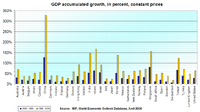
Photo from wikipedia
This paper examines the effects of accounting-based thresholds in regulation on growth decisions in the banking industry. To investigate this relation we study changes in growth around the $10 billion… Click to show full abstract
This paper examines the effects of accounting-based thresholds in regulation on growth decisions in the banking industry. To investigate this relation we study changes in growth around the $10 billion asset threshold specified in the Dodd-Frank Act. We first document that, in the years after the new threshold-based regulations are announced, banks slow their asset growth as they approach the threshold and then accelerate their asset growth as they cross the threshold. Next, we document the primary mechanism banks use to achieve each of these changes in growth: reduced deposit growth rates to slow growth and increased acquisition activity to accelerate growth. Finally, we document that, while banks attempt to remain below the threshold, they reduce the growth of their investment portfolio and report a lower return on assets. Also, when banks accelerate growth through acquisition activity, those acquisitions involve larger and riskier target banks. These findings suggest that regulations with accounting-based thresholds can affect growth decisions and profitability in the banking industry.
Journal Title: Review of Accounting Studies
Year Published: 2021
Link to full text (if available)
Share on Social Media: Sign Up to like & get
recommendations!